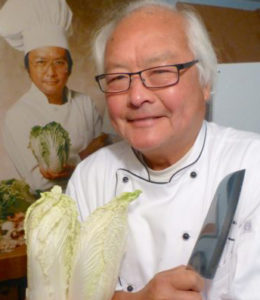Wok & Roll by Peter Kwong, (Frederic) Inter-County Leader
» Download this column as a Word document
I’ve been teaching cooking classes all over — River Falls, Spooner, Unity, Amery, St. Croix Falls, Rice Lake, and now, even in North Branch. Never heard of North Branch before, just to find out it is an hour east of Taylors Falls, which is located in Minnesota across the border from where we live.
When I got a call from the community ed director of North Branch, I was just curious of how she has heard about me, as I have no idea where North Branch is.

“Oh, that was easy,” she said. “I just googled community education and your name; and the classes that you have taught just popped up.”
Goodness, I don’t know if I should feel honored or scared. Well, at least I got my fame now;
I taught an Italian cooking class in Rice Lake a few weeks ago. We did fettuccine alfredo, shrimp scampi, authentic garlic toast, and bruschetta.
By the way, it is pronounced “bro-ska-ta,” and not “bro-shet-ta.” I made a mistake once when I was working with an Italian chef at the culinary school. She almost threw a knife at me when I
She refrained from calling me names as there were students present. But her voice reinforced that I would be in trouble if she ever heard me pronounce it wrong again in front of her. What a lesson to learn. A good one though, as I will never ever pronounce the name wrong again. Thank goodness that we’re still friends.
Anyway, I was thinking of cooking something different instead of the usual spaghetti and meatballs. When I went shopping for the class, I saw some artichokes in the produce department.
Hmm, why not teach the class how to cook and eat an artichoke? Glad I did, as no one in the class knew what an artichoke is, not to mention has dared to try one.
So, I took a chance and experimented with the class. Lo and behold, they all loved it. I thought to myself, why not share this with my reader friends? We all need to think outside the box and be daring sometimes.
I’ve yet to try lutefisk. So, I’ll hold back on my venturesome thoughts for the time being.
An artichoke looks like
It originated in the Mediterranean
They are good for your liver, and can cure hangovers! I was told that one would feel better chewing on the leaves after a long, hard night of heavy drinking.
Wouldn’t it be great if that works? All the bars would have a bowl of artichoke leaves for you to munch on after they give
Anyway, just how do you cook this ugly ball of prickly leaves; and how to enjoy eating it without sticking your lips and tongues with thistles and needles? Well, there are many ways to skin a cat, so to speak. (Don’t let my wife know that I said that. She loves her cats.)
I always like the easy way out. We should spend more time eating and enjoying each other’s company than to spend hours slaving
- In a large pot, bring a gallon of water to a boil.
- Add 1 teaspoon of salt, 1/2 cup of olive oil and 1 fresh lemon (cut in half, and squeeze in the juice).
Then:
- Cut off the stems of the artichokes, and 1 inch off the top.
- Put all artichokes in boiling water and cook for 20 to 30 minutes.
- They are ready when you pull on a leaf and it comes right out.
It works better with a pressure cooker. Don’t sweat it if you do not have one; just let the boiling water do the work.
While waiting, fill four small dishes with melted butter and a tablespoon of mayo in each; that’s for dipping.
Get an extra large bowl for discarded leaves.
How to eat an artichoke:
- Gently remove the leaves, one at a time.
- Dip the bottom part in the mayo and butter mix, and just bite off the bottom part.
- Do not eat the leaf, that’s what the large bowl is for.
- When all the leaves are gone, the show has just begun!
- The bottom (or the crown) is topped with thistle (or the choke), do not eat.
- Gently remove the thistle (or choke) with a spoon.
- Cut the crown (or heart) in quarters, dip in the butter mix and enjoy.
Needless to say, the heart is the best part of the artichoke. Some brownie points for the husbands: Dip the pieces of the heart generously in the butter mix, and then feed it to your other half, say something clever like:
- “Honey, here is my heart.”
- “Now, I give all my heart to you, dearest.”
- “Here, this is all I got, enjoy.”
She might roll her eyes or start to cry. Use your charm, gentlemen
They do sell artichoke hearts in a can. They are the tender hearts that are harvested before the flowers mature. You can eat the whole thing and do not have to worry about the thistle, as they have not started to grow yet
Those hearts are great with salads. Also, there are marinated artichoke hearts; and oh, are they delicious! If you like pickled mushrooms, asparagus or olives, you’ll love those
My book “Wok & Roll” is available at phkwong.com and is now available at the Polk County Information Center in St. Croix Falls and the Inter-County Leader office in Frederic.



